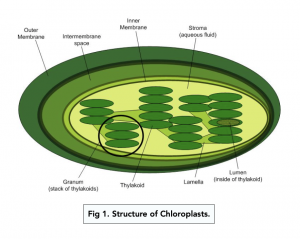Site of Photosynthesis
Site of Photosynthesis
Site of Photosynthesis
The process of photosynthesis occurs in the chloroplasts, which absorbs light, in plants. Chloroplasts are specially adapted to preform such a reaction and produce ATP energy, continuing the next stage of photosynthesis.
Some adaptations of chloroplasts are:
- Grana – these are stacks of thylakoid membranes which contain photosynthetic pigments, for example, chlorophyll. They are arranged as photosystems.
- Stroma – this is the fluid surrounding the grana which contains the necessary enzymes required for the light-independent stage of photosynthesis.
Photosynthesis occurs in all photoautotrophs. Remember, an autotroph is an organism that can make its own food, and ‘photo’ means using light.
Chloroplasts
Structure of Chloroplasts
Chloroplasts have an inner membranes called the thylakoid membranes. The thylakoid membranes are very important structures in chloroplasts. These membranes are small and thin and can be stacked up into structures called grana (one stack is a granum). Grana contain chlorophyll.
Thylakoids are a group of membranous sacs, which are known as grana when arranged in groups of between 10-20. The light-dependent reactions of photosynthesis take place in the chlorophyll of the grana.
The area around the thylakoids are known as the stroma. Stroma is a thick, viscous, alkaline fluid that fills up most of the chloroplast and is rich in proteins. This is where light-independent reactions occur. Chloroplast DNA, ribosomes and the thylakoid system are found in this fluid.
Chloroplasts have a double-membrane envelope with outer and inner layers, where the gap between these is known as the inter membrane space. The membranes are phospholipid bilayers.
Lamellae in the chloroplasts act to keep thylakoids at a safe distance of each other whilst also connecting them together. If the distance between each grana is too small, photosynthetic efficiency begins to deteriorate.






Still got a question? Leave a comment
Leave a comment